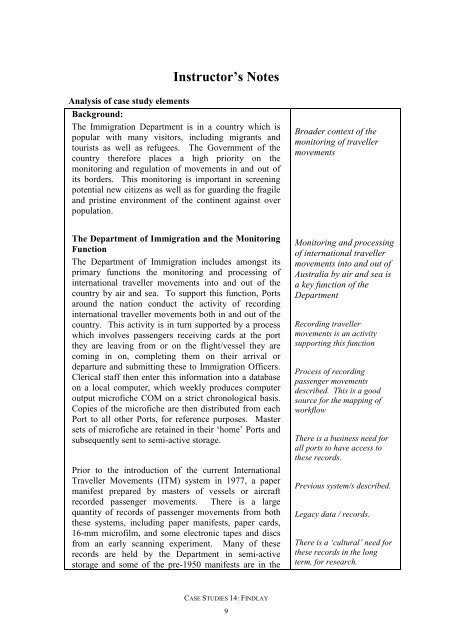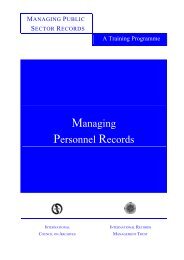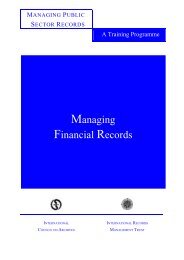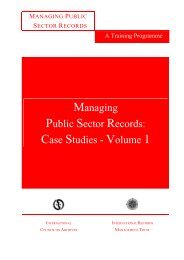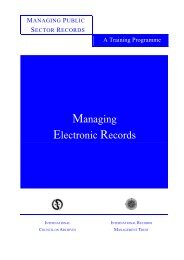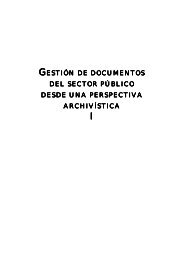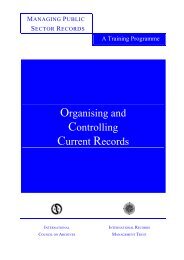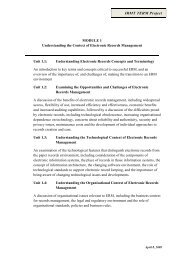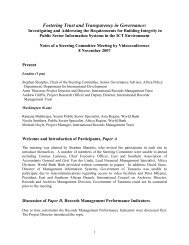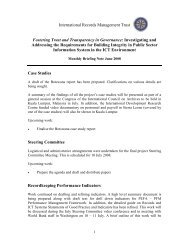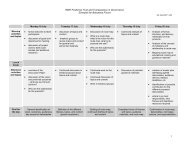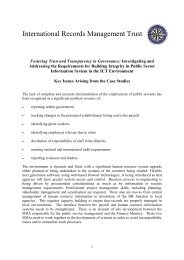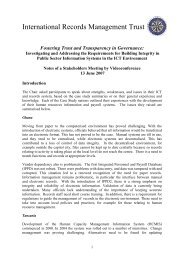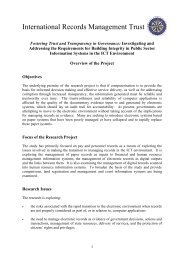managing public sector records: a study programme - International ...
managing public sector records: a study programme - International ...
managing public sector records: a study programme - International ...
Create successful ePaper yourself
Turn your PDF publications into a flip-book with our unique Google optimized e-Paper software.
Instructor’s Notes<br />
Analysis of case <strong>study</strong> elements<br />
Background:<br />
The Immigration Department is in a country which is<br />
popular with many visitors, including migrants and<br />
tourists as well as refugees. The Government of the<br />
country therefore places a high priority on the<br />
monitoring and regulation of movements in and out of<br />
its borders. This monitoring is important in screening<br />
potential new citizens as well as for guarding the fragile<br />
and pristine environment of the continent against over<br />
population.<br />
The Department of Immigration and the Monitoring<br />
Function<br />
The Department of Immigration includes amongst its<br />
primary functions the monitoring and processing of<br />
international traveller movements into and out of the<br />
country by air and sea. To support this function, Ports<br />
around the nation conduct the activity of recording<br />
international traveller movements both in and out of the<br />
country. This activity is in turn supported by a process<br />
which involves passengers receiving cards at the port<br />
they are leaving from or on the flight/vessel they are<br />
coming in on, completing them on their arrival or<br />
departure and submitting these to Immigration Officers.<br />
Clerical staff then enter this information into a database<br />
on a local computer, which weekly produces computer<br />
output microfiche COM on a strict chronological basis.<br />
Copies of the microfiche are then distributed from each<br />
Port to all other Ports, for reference purposes. Master<br />
sets of microfiche are retained in their ‘home’ Ports and<br />
subsequently sent to semi-active storage.<br />
Prior to the introduction of the current <strong>International</strong><br />
Traveller Movements (ITM) system in 1977, a paper<br />
manifest prepared by masters of vessels or aircraft<br />
recorded passenger movements. There is a large<br />
quantity of <strong>records</strong> of passenger movements from both<br />
these systems, including paper manifests, paper cards,<br />
16-mm microfilm, and some electronic tapes and discs<br />
from an early scanning experiment. Many of these<br />
<strong>records</strong> are held by the Department in semi-active<br />
storage and some of the pre-1950 manifests are in the<br />
CASE STUDIES 14: FINDLAY<br />
9<br />
Broader context of the<br />
monitoring of traveller<br />
movements<br />
Monitoring and processing<br />
of international traveller<br />
movements into and out of<br />
Australia by air and sea is<br />
a key function of the<br />
Department<br />
Recording traveller<br />
movements is an activity<br />
supporting this function<br />
Process of recording<br />
passenger movements<br />
described. This is a good<br />
source for the mapping of<br />
workflow<br />
There is a business need for<br />
all ports to have access to<br />
these <strong>records</strong>.<br />
Previous system/s described.<br />
Legacy data / <strong>records</strong>.<br />
There is a ‘cultural’ need for<br />
these <strong>records</strong> in the long<br />
term, for research.


